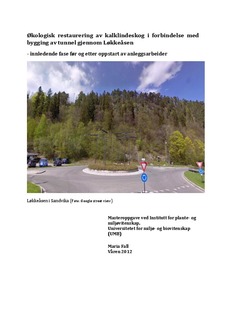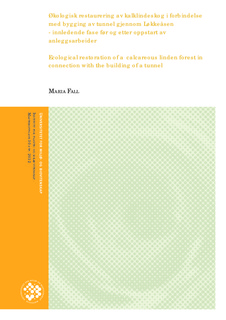| dc.description.abstract | I forbindelse med tunellbygging gjennom en kalklindeskog i Løkkeåsen, Sandvika, ble deler av området planlagt for økologisk restaurering etter ferdigstillelse. Kalklindeskog er en sjelden naturtype både på verdensbasis og i Norge, og er blitt utsett til en av Norges første utvalgte naturtyper, der den rommer store bevaringsverdier gjennom å være habitat for svært gammel lind og meget sjelden sopp på den norske rødlisten. Som første ledd i restaureringsarbeidet ble det bestemt å minimere inngrepsonen, innføre restriksjoner på hvilke trær som kunne hogges og å lagre toppjorden på stedet for senere tilbakelegging. Det ble gjennomført vegetasjonsregistrering i forkant av anleggsstart. Vegetasjonsregistreringen ble utført i feltsjikt, busksjikt og tresjikt med mål om å kartlegge artsforekomster, påvirkningsfaktorer samt å gi en beskrivelse av området så som det forelå før inngrep. Trærne ble fotografert og posisjonsmarkert med GPS og antall levende/døde stammer samt største stammediameter ble målt for hvert tre av artene småbladlind (Tilia cordata) og hassel (Corylus avellana). For å sikre bevaring av genetisk materiale fra området ble det utført forsøk med stiklingsformering av stedegen småbladlind og hassel. Stiklingene ble plukket ut i to omganger med 21 dagers mellomrom, der første uttak var begynnelsen og andre uttak var slutten av juni. Halvparten av materialet ble stukket med rotingshormonet IBA og halvparten ble stukket uten. I forbindelse med anleggsarbeidene ble det registrert avvik mellom planer og praksis, som ga redusert restaureringsareal og en sannsynlig forringelse av toppjorden som konsekvens. Vegetasjonsregistreringen viste at området inneholdt mange typiske og viktige arter for naturtypen, men også arter ikke hjemmehørende som på sikt kan ha evne til å forandre områdets karakter. Andre påvirkningsfaktorer ble også observert i form av fragmentering og tap av habitat. Kun 30 av 400 stiklinger rotet seg og overlevde omplanting hos hassel, sammenliknet med 125 stiklinger av 400 for lind. Det var stor forskjell i rotingsevne og overlevelse mellom uttakene for hassel og antall rotede stiklinger var størst i gruppen som hadde fått IBA. Roting til lind så ut å ha sammenheng med karakterstrekk hos morplanten. Målsetningen om å få nok stedseget stiklingsmateriale til utplanting ble ansett som oppfylt. In connection with the building of a tunnel through a calcareous linden forest in Løkkeåsen, Sandvika, part of the area was planned for ecological restoration. The calcareous linden forest represents a rare piece of nature worldwide and in Norway. It has recently been prioritized under the regulation of “chosen nature types”, as an area to which special consideration should be taken. Calcareous linden forests are very important to conserve since they contain extremely old linden trees and are also habitat to the majority of rare fungi found on the Norwegian list of rare species. In the initial process of the restoration plan, it was decided that the zone where construction could be performed should be restricted, restriction to which trees that could be removed should be established, and topsoil from the area should be removed and stored in connection to the site. The vegetation was registered, with the aim to map species and uncover factors that could influence the characteristics of the forest, and also to function as a description of what the area looked like before beginning of the construction. The trees where photographed and position marked with GPS. The number of living/dead trunks and the diameter of biggest trunk where recorded for each linden (Tilia cordata) and filbert (Corylus avellana) tree. To ensure that genetic material was conserved, a rooting trial with cuttings of linden and filbert was performed, where the cuttings was collected at two different times, one in early and one in late June. Half of the cutting material was put in the rooting tray untreated and the other half received treatment with the rooting hormone IBA.
A deviation between plans and practice was recorded during the construction work, with reduced restoration area and possibly a reduction in the quality of the top soil as consequence. The registration showed that the area contained many typical and important species, and also revealed a number of species not indigenous to the habitat, which could have a long term effect on the forest. Other influential factors where observed, such as fragmentation and loss of habitat. Only 30 out of 400 cuttings developed roots and survived transplanting in the filbert compared to 125 out of 400 in linden. Big differences in rooting ability and survival were recorded between the two collection dates in filbert and number of rooted cuttings was bigger in the group that had received IBA. For linden there seemed to be a connection between characters of the mother plant and rooting. The aim to get enough genetically indigenous transplants to cover the restoration area was considered fulfilled. | no_NO |

